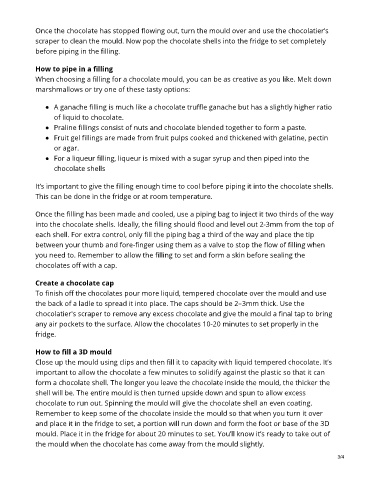Page 613 - YC Cooking School
P. 613
Once the chocolate has stopped flowing out, turn the mould over and use the chocolatier’s
scraper to clean the mould. Now pop the chocolate shells into the fridge to set completely
before piping in the filling.
How to pipe in a filling
When choosing a filling for a chocolate mould, you can be as creative as you like. Melt down
marshmallows or try one of these tasty options:
A ganache filling is much like a chocolate truffle ganache but has a slightly higher ratio
of liquid to chocolate.
Praline fillings consist of nuts and chocolate blended together to form a paste.
Fruit gel fillings are made from fruit pulps cooked and thickened with gelatine, pectin
or agar.
For a liqueur filling, liqueur is mixed with a sugar syrup and then piped into the
chocolate shells
It’s important to give the filling enough time to cool before piping it into the chocolate shells.
This can be done in the fridge or at room temperature.
Once the filling has been made and cooled, use a piping bag to inject it two thirds of the way
into the chocolate shells. Ideally, the filling should flood and level out 2-3mm from the top of
each shell. For extra control, only fill the piping bag a third of the way and place the tip
between your thumb and fore-finger using them as a valve to stop the flow of filling when
you need to. Remember to allow the filling to set and form a skin before sealing the
chocolates off with a cap.
Create a chocolate cap
To finish off the chocolates pour more liquid, tempered chocolate over the mould and use
the back of a ladle to spread it into place. The caps should be 2–3mm thick. Use the
chocolatier's scraper to remove any excess chocolate and give the mould a final tap to bring
any air pockets to the surface. Allow the chocolates 10-20 minutes to set properly in the
fridge.
How to fill a 3D mould
Close up the mould using clips and then fill it to capacity with liquid tempered chocolate. It’s
important to allow the chocolate a few minutes to solidify against the plastic so that it can
form a chocolate shell. The longer you leave the chocolate inside the mould, the thicker the
shell will be. The entire mould is then turned upside down and spun to allow excess
chocolate to run out. Spinning the mould will give the chocolate shell an even coating.
Remember to keep some of the chocolate inside the mould so that when you turn it over
and place it in the fridge to set, a portion will run down and form the foot or base of the 3D
mould. Place it in the fridge for about 20 minutes to set. You’ll know it’s ready to take out of
the mould when the chocolate has come away from the mould slightly.
3/4

